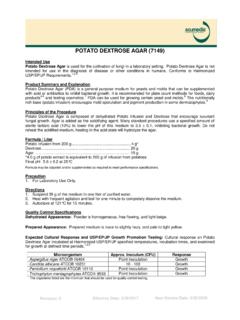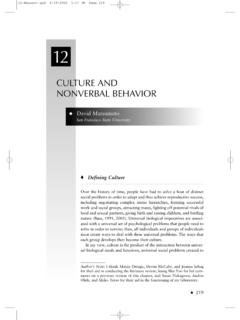Transcription of 1. Algae - fao.org
1 31. AlgaeAlgae have been used in animal and human diets since very early times. Filamentous Algae are usually considered as macrophytes since they often form floating masses that can be easily harvested, although many consist of microscopic, individual filaments of algal cells. Algae also form a component of periphyton, which not only provides natural food for fish and other aquatic animals but is actively promoted by fishers and aquaculturists as a means of increasing productivity. This topic is not dealt with in this section, since periphyton is not solely comprised of Algae and certainly cannot be regarded as macroalgae.
2 However, some ancillary information on this topic is provided in Annex 2 to assist with further reading. Marine seaweeds are macro- Algae that have defined and characteristic structures. Microalgal biotechnology only really began to develop in the middle of the last century but it has numerous commercial applications. Algal products can be used to enhance the nutritional value of food and animal feed owing to their chemical composition; they play a crucial role in aquaculture. Macroscopic marine Algae (seaweeds) for human consumption, especially nori (Porphyra spp.)
3 , wakame (Undaria pinnatifida), and kombu (Laminaria japonica), are widely cultivated algal crops. The most widespread application of microalgal culture has been in artificial food chains supporting the husbandry of marine animals, including finfish, crustaceans, and molluscs. The culture of seaweed is a growing worldwide industry, producing million tonnes (wet weight) worth US$ billion in 2007 (FAO, 2009). The use of aquatic macrophytes in treating sewage effluents has also shown potential.
4 In recent years, macroalgae have been increasingly used as animal fodder supplements and for the production of alginate, which is used as a binder in feeds for farm animals. Laboratory investigations have also been carried out to evaluate both Algae and macroalgae as possible alternative protein sources for farmed fish because of their high protein content and and macroalgae are also used as components in polyculture systems and in remediation; although these topics are not covered in this paper, information on bioremediation is contained in many publications, including Msuya and Neori (2002), Zhou et al.
5 (2006) and Marinho-Soriano (2007). Red seaweed (Gracilaria spp.) and green seaweed (Ulva spp.) have been found to suitable species for bioremediation. The use of Algae in integrated aquaculture has also been recently reviewed by Turan (2009). ClASSIFICAtIonThe classification of Algae is complex and somewhat controversial, especially concerning the blue-green Algae (Cyanobacteria), which are sometimes known as blue-green bacteria or Cyanophyta and sometimes included in the Chlorophyta. These topics are not covered in detail this document.
6 However, the following provides a taxonomical outline of Chlorophyta (green Algae ) Rhodophyta (red Algae ) GlaucophytaRhizaria, Excavata ChlorarachniophytesUse of Algae and aquatic macrophytes as feed in small-scale aquaculture A review4 Euglenids Chromista, Alveolata Heterokonts Bacillariophyceae (diatoms) Axodine Bolidomonas Eustigmatophyceae Phaeophyceae (brown Algae ) Chrysophyceae (golden Algae ) Raphidophyceae Synurophyceae Xanthophyceae (yellow-green Algae ) Cryptophyta Dinoflagellates HaptophytaThe following sections discuss the characteristics and use of both true Algae and the Cyanophyta, hereinafter referred to as blue-green Algae ).
7 ChARACtERIStICSF ilamentous Algae and seaweeds have an extremely wide panorama of environmental requirements, which vary according to species and location. Ecologically, Algae are the most widespread of the photosynthetic plants, constituting the bulk of carbon assimilation through microscopic cells in marine and freshwater. The environmental requirements of Algae are not discussed in detail in this document. However, the most important parameters regulating algal growth are nutrient quantity and quality, light, pH, turbulence, salinity and temperature.
8 Macronutrients (nitrate, phosphate and silicate) and micronutrients (various trace metals and the vitamins thiamine (B1), cyanocobalamin (B12) and biotin) are required for algal growth (Reddy et al., 2005). Light intensity plays an important role, but the requirements greatly vary with the depth and density of the algal culture. The pH range for most cultured algal species is between 7 and 9; the optimum range is Marine phytoplankton are extremely tolerant to changes in salinity. In artificial culture, most grow best at a salinity that is lower than that of their native habitat.
9 Salinities of 20 24 ppt are found to be optimal. Lapointe and Connell (1989) suggested that the growth of the green filamentous alga Cladophora was limited by both nitrogen and phosphorus, but the former was the primary factor. Hall and Payne (1997) found that another green filamentous alga, Hydrodictyon reticulatum, had a relatively low requirement for dissolved inorganic nitrogen in comparison with other species. Rafiqul, Jalal and Alam (2005) found that the optimum environment for Spirulina platensis under laboratory conditions was 32 C, 2 500 lux and pH Further information on the environmental requirements of Algae cultured for use in aquaculture hatcheries is contained in Lavens and Sorgeloos (1996).
10 The environmental requirements of cultured seaweeds are discussed by McHugh (2002, 2003).A brief description of some of the filamentous Algae and seaweeds that have been used for feeding fish, as listed in Tables , is provided in the following Filamentous algaeFilamentous Algae are commonly referred to as pond scum or pond moss and form greenish mats upon the water surface. These stringy, fast-growing Algae can cover a pond with slimy, lime-green clumps or mats in a short period of time, usually beginning their growth along the edges or bottom of the pond and mushrooming to the surface.
















